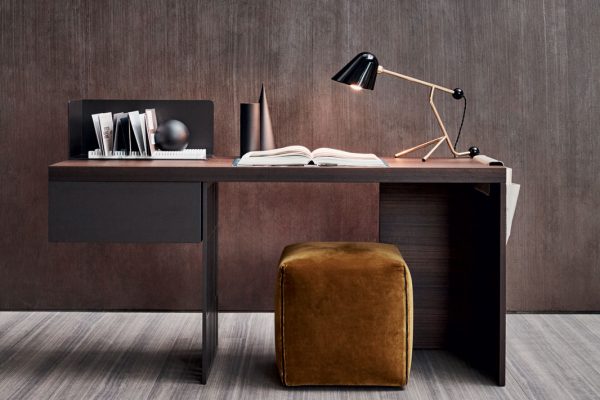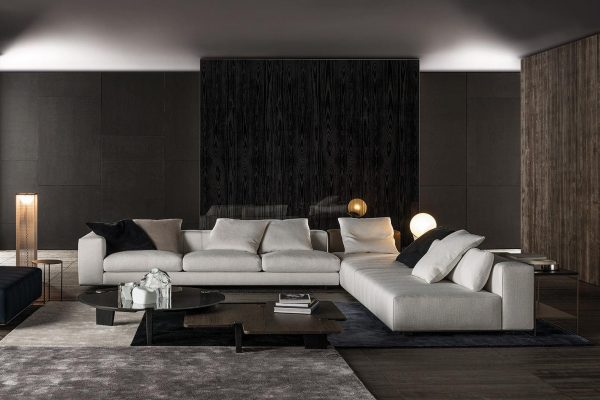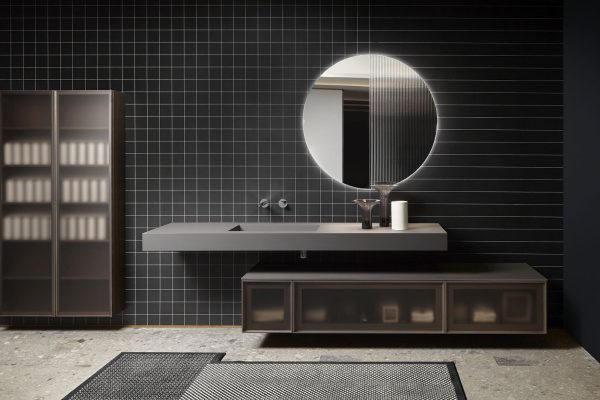Minotti: refined, modern living with timeless style
It is the most lived-in area of the house, the one where people spend most of their time, where they meet guests, relate to each other, eat, rest, and most frequently carry out their recreational and other activities.
Living, the hub of the home, the place that most embodies our culture of living and experiencing the spaces we have available to us. This is precisely why it ends up encapsulating our aesthetics, inspirations, and memories, because it represents the happy island to which we return every day after work to find ourselves. Precisely for this reason, it is of paramount importance to furnish it with style, following one’s tastes, choosing materials that are more in line with our perception of space. To compose the living area, normally, there are must-haves such as a comfortable sofa, table, side tables, console table and, if we want, armchairs, strictly design, to give personality to the whole room.
Minotti, a Made in Italy excellence founded in 1948 in Meda by Alberto Minotti and specializing precisely in embellishing the living room by combining artisanal savoir faire and innovation, has been creating furniture that is rich in contaminations, precious, made with top-range materials and sartorial attention, and with a very strong identity for more than 70 years. Their proposals give character to the environment, retracing pieces of design history.
Roger, a sofa to compose with imagination and customize with style
When Roger was born from the idea ofarchitect Rodolfo Dordoni, the intent was to create a site-specific installation that could vary its size each time depending on the space that hosts it. Multifaceted, to meet every layout and intended use, and at the same time capable of intercepting multiple target tastes, it offers a very wide range of variations that make it extremely versatile and limitless in design.
The system created for Minotti embraces three types of elements: Roger Suite, with a seat cushion and a depth of 101 cm; Roger Spring, a one-piece seat of the same depth, with an internal insert of pocketed springs that guarantees non-deformability to the seat, completely quilted on the surface; and, finally, the Roger Spring Sofa with a depth reduced to 94 cm and without armrests.
The elements are freely designable with high and low backs, different types of armrests, and the possibility of inserting support and storage elements, cantilevered at the back or in an end position adjacent to the seat. A system, or rather a super system, capable of an exponential number of interpretations and configurations, both in residential and hospitality settings. The sofa features a custom-designed drawn aluminum base, painted Black Coffee color, on which the upholstered seats and Case volumes rest in Santos rosewood stained Dark Brown, striped ashwood lacquered open-pore Black color or lacquered Ice, Cappuccino and Mocha, with an open front or side storage compartment lined in brushed aluminum in Brandy color.
Brutalist inspiration for the rectangular Block table-sculpture.
To look at it it looks like a sculpture with that typically Brutalist plasticity, but instead Block is a small table made for Minotti by Rodolfo Dordoni, a piece of furniture with a strong identity. With a solid wood block structure, the Block coffee table has a base designed as a solid volume in the shape of an “L” or inverted “T.” Made of Moka-colored lacquered oak wood, it is complemented by a top that lets its graft appear on its surface. The top has a plastic aesthetic with edges polished like a river stone and a tactile glossy lacquer finish, declined in a color palette ranging from White, to Rust, to Mocha.
Boteco, coffee table that perfectly mixes elegance and exotic aesthetics
An elegant and harmonious aesthetic albeit with exotic features is mixed with the skillful combination of different materials. These are the features behind the Boteco coffee table, revealing the architectural approach of Marcio Kogan, the Brazilian architect who designed them for Minotti. Boteco side tables feature a low height and a significant top thickness of 8 cm that accommodates a recessed tray. They are offered in both matte lacquered Eucalyptus essence and matte polyester lacquered Santos rosewood, both paired with the matte polyester lacquered Sahara Noir marble that lines the recessed tray. Alternatively, a Grigio Orobico marble top accommodates a lowered metal tray with a Golden Brown finish, as do the support legs. The edge of the tray protrudes from the top by 15 mm.
Daiki, Kogan’s signature seating inspired by Japan
Brazilian architect Marcio Kogan‘s passion for Japanese culture with Daiki seating also explores and reinterprets Mid-Century American atmospheres in its sharp, dry lines, fine materials, and balanced proportions. Made with sophisticated woodworking, the curved shell consists of two elements joined at 45° with a backrest tilt that provides great seating comfort. Veneered in Santos rosewood or Liquorice lacquered flamed ash, the shell precisely accommodates the cushioning and rests on a metal frame with Black-Nickel finish legs. The family accommodates armchairs with deep seats, with and without armrests, and footrests.
Solid, the square console table that makes the room sophisticated
Rodolfo Dordoni in developing Solid, the square console table of the Minotti family, thought of starting from a simple volume to give versatility, through the essentiality of their shape.
The Solid family consists of elements that differ in form and function. Square and with cubist matrix intervene to characterize residential and Hospitality interiors with their decisive personality. Solid low tables, in all sizes, are available in both glossy lacquer in Corten, Moss, Petroleum and Moka colors and in Moka-colored open-pore ash finish. Some of them prove useful storage elements thanks to drawers, with Moka-colored ash interiors and push & pull opening, almost imperceptible to the eye thanks to perfect aesthetics. These range from parallelepiped volume, with a suitable height to be placed next to even a dining table as an additional seat, to small tables with simple support or storage functions, to a nightstand element for the sleeping area. Completing the rich ensemble is the console, which rests on metal blades with a Black-Nickel finish.
Linha, refined table with minimalist allure
An expression of the minimalism so beloved of Brazilian architect Marcio Kogan, The Linha Table, is a manifesto of the constant search for elegance in proportion and almost obsessive attention to detail. It is a response to the design challenge of a dining table with a large span, a structure with a thin thickness of only 16 mm and a top that reaches 4 meters in length. Visually, it appears extremely light and airy, despite the strong impact of the materials used, which feature marble as the absolute protagonist. In its most sculptural version, the frame draws a bridge, with the top flush with the sides, while in the other tables the blade legs, with a curved section on the inner side, are set back from the top. The layered supporting structure, features aluminum sides with a Golden Brown finish and a visually striking Orobic Grey marble top. Completing the Linha series is a round version available in four sizes.



